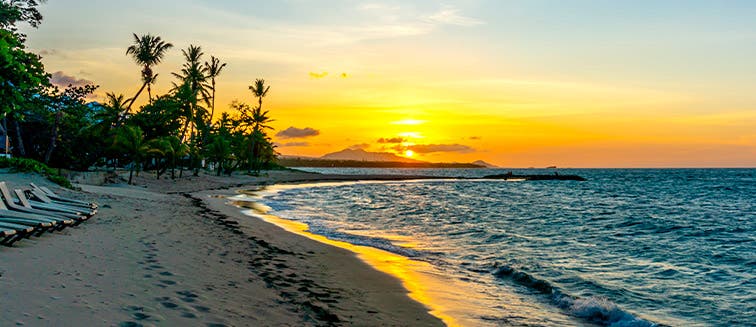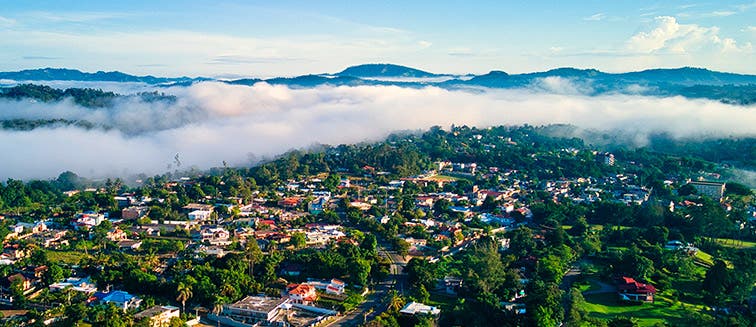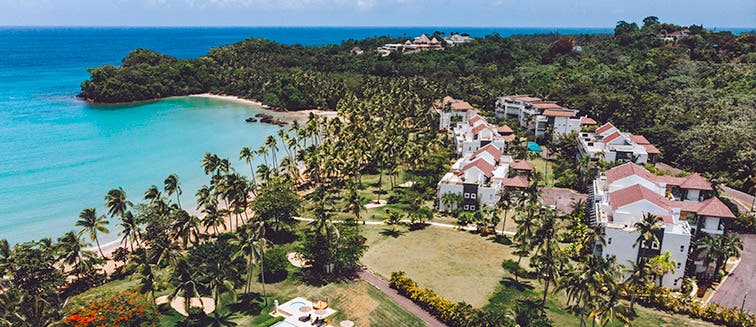When it comes to Caribbean holidays, the Dominican Republic is the most popular destination for limitless sun, sand, sea and sunshine! Occupying the eastern part of the island of Hispanola, this country is naturally blessed with paradise beaches and lush, tropical landscapes. A holiday to the Dominican Republic is the chance to indulge in a slower pace of life against the backdrop of turquoise seas and swaying palm trees. The second-largest Caribbean nation, the Dominican Republic is within easy reach of North America and is the ideal destination for a laid-back escape, away from the hustle and bustle of our busy lives. Part of the Greater Antilles, the Dominican Republics’s capital city of Santo Domingo is the oldest continuously inhabited European settlement in the Americas and the first centre of Spanish colonial rule in the 'New World'. Combine this impressive history with picture-perfect beaches and exotic scenery and you’re sure to understand why package holidays to the Dominican Republic are eternally popular!
Whilst the luxury resorts of Punta Cana are where holiday-makers prefer to base themselves, there’s more to this country than all-inclusive hotels and endless stretches of coastline. In fact, the Dominican Republic is incredibly diverse, boasting a variety of eco-systems and wildlife. From whale-watching off the coast of Samana to mountain biking through the Cordillera Central and scuba diving in the Caribbean Sea, there’s much to do if you travel to the Dominican Republic. Add to this a vibrant cultural scene, where street parties go on for days against the backdrop of the intoxicating rhythms of merengue and bachata and you’ve got a simply fascinating and rewarding travel destination, where you can do as much, or as little, as your desire.
History of the Dominican Republic
The Dominican Republic boasts a long and complex history. Before the arrival of Europeans, the island of Hispanola was inhabited by the indigenous communities of the Caribbean, namely the Taino people. Constructing an advanced hunting and farming society, the influence of Taino culture can still be experienced if you travel to the Dominican Republic today. Taino Park, situated near Samana, offers interesting exhibits detailing Taino history and culture, whilst the Pomier Caves are home to prehistoric art left by ancient Taino inhabitants. Famously, Christopher Columbus landed on the island in 1492 during his first voyage to the Americas. Claiming the island for Spain, he named it La Española and shortly afterwards, the city of Santo Domingo was built. As the first permanent European settlement in the ‘New World’, the city was of great importance and a stroll through the historic, UNESCO-protected centre of Santo Domingo today reveals many colonial-era buildings, fortresses and churches. A plantation economy was created on the island and many indigenous inhabitants tragically suffered and died at the hands of this new feudal-style form of governance. Over the following centuries, the story of La Española was one of colonial wars and conflicts between European powers, including the Spanish, French and English. In the late-17th century, France took control of the western part of the island, which became known as Haiti. Following 300 years of Spanish rule, the Dominican people declared independence in November 1821, but shortly thereafter this newly free nation was annexed by neighbouring Haiti. The 1844 Dominican War of Independence resulted in the country’s freedom once more, yet civil wars ensued, followed by occupation by the United States during the early part of the 20th-century. For 31 years between 1930 and 1961, the Dominican Republic was under the dictatorship of Rafael Leónidas Trujillo, considered one of the most violent regimes in the history of the Americas. A few years after his assassination, the Dominican Republic experienced its final civil war before moving towards a more representative and democratic form of government. Today, the Dominican Republic has the largest economy in the Caribbean and is a safe and much sought-after travel destination.
Nature in the Dominican Republic
The most naturally diverse country in the Caribbean, if you travel to the Dominican Republic you’ll encounter an array of eco-systems. From the towering peaks of the Cordillera Central, the highest mountain range in the region, to the sun-kissed white sand beaches of the east coast and the dense mangroves of the northeast, the Dominican Republic invites you to explore its rich biodiversity. With its varying altitudes, as you travel throughout the Dominican Republic you’ll notice how the weather changes quite rapidly. Despite this, holidays to the Dominican Republic will most likely involve plenty of time on the coast, where you can expect year-round sunshine and temperatures around 25 °C.
It might be tempting to stay on the beach, but you’d be seriously missing out as the Dominican Republic boasts some incredible natural wonders. One such wonder is the idyllic Samana peninsula, known for its migratory humpback whales and dense rainforests. Kayaking through the mangroves and exploring the Salto El Limon waterfall are some of the most popular activities here. It’s also the jumping-off point for adventures into the Los Haitises National Park. On the other hand, the south of the island is home to more arid landscapes, including the sand dunes and salt mines of Bani and the unique biodiversity of Las Calderas Bay. If you’re into hiking, be sure to explore the interior of the Dominican Republic, where towering mountains and lush valleys offer plenty of challenging trails for those in search of untouched wildernesses. Of course, no trip to the Dominican Republic would be complete without exploring its tiny islands and cays, such as Catalina and Saona, where you can experience true desert-island tranquillity!
Culture in the Dominican Republic
A fusion of Spanish, African and Indigenous influences, Dominican culture is both traditional and flamboyant. From the sanctity of the country’s Saint’s Days to the collective love of dance and street parties, religion and community are both important pillars of everyday life in the country. The majority of the population identifies as Christian, and therefore you’ll notice a great number of churches and enthusiastic celebrations on important religious dates if you visit the Dominican Republic. The official language is Spanish, whilst both French and English are taught as foreign languages in schools.
The Dominican Republic is well known for its artistic traditions, and Dominican artists have long produced many fine works of art. If you are on holiday in the Dominican Republic, be sure to explore the country’s galleries and craft markets to appreciate the vibrant artistic traditions that still endure to this day. When it comes to the national cuisine, Dominican food is also a mix of European, African and Indigenous influences. Quite similar to that found in Latin American countries, you’ll likely recognise many of the most popular dishes if you've travelled to other Spanish-speaking nations.
Of course, if there’s one thing the Dominican Republic is famous for, it's merengue, a musical genre known for its fast-paced, lively rhythm. Furthermore, bachata also has its roots in Dominican culture and despite the passing of time, these musical styles are still extremely popular and can be heard at any Dominican street party or any dance club across the country. If you want to experience ‘DR’ in all its glory, be sure to join in with one of the frequent fiestas patronales during your visit!
A holiday to the Dominican Republic is the chance to experience a Caribbean paradise with incredible history, breathtaking natural sights and warm hospitality. Whether you’re here for the white-sand beaches of Punta Cana or the vibrant nightlife of Santo Domingo, you’re sure to fall in love with the beaches, culture and landscapes when you choose a trip to the Dominican Republic with Exoticca!








